Remnants of a Khmer Rouge Era
A staggering 1.7 million people lost their lives during the Khmer Rouge regime in Cambodia. As visitors traverse the haunting remnants of this dark era, they are confronted with a chilling reminder of the atrocities that once plagued the nation.
The echoes of history resonate through the Tuol Sleng Museum and the Cheung Ek Killing Fields, beckoning travelers to witness the stark realities of Cambodia’s past. But what untold stories lie within these somber sites, waiting to be unearthed by those who dare to explore further?
Key Points
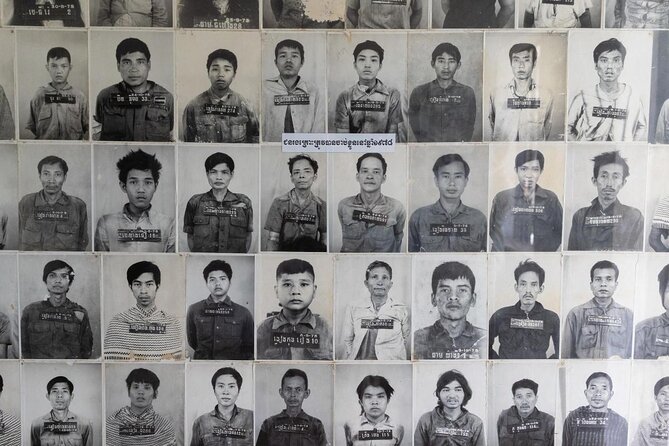
- Collective memory shaped by Khmer Rouge atrocities
- Trauma’s intergenerational impact on Cambodian society
- Memorial sites crucial for honoring victims and educating
- Reminder to prevent extremist ideologies and atrocities
Historical Context of Khmer Rouge Regime
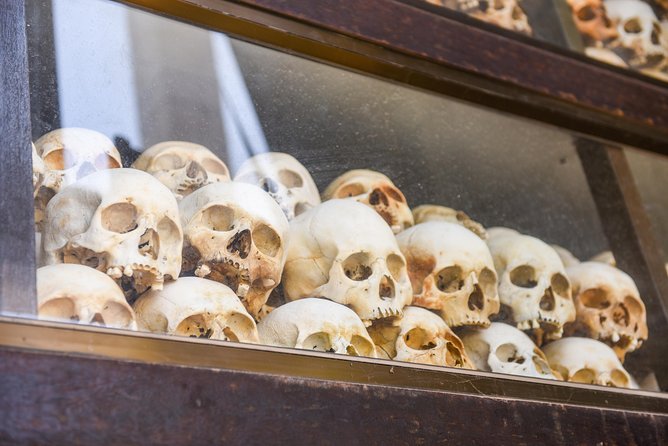
During the late 1970s, Cambodia was under the brutal grip of the Khmer Rouge regime, led by Pol Pot, inflicting widespread suffering and devastation on its people.
The Khmer Rouge atrocities marked one of the darkest periods in Cambodian history, with an estimated 1.7 million people losing their lives due to execution, forced labor, starvation, and disease.
Under Pol Pot’s leadership, the regime aimed to create an agrarian socialist society by forcefully evacuating cities, abolishing religion, education, and currency, and establishing labor camps.
The ruthless policies of the Khmer Rouge led to the decimation of families, communities, and traditional Cambodian ways of life.
This chapter in Cambodian history serves as a stark reminder of the horrors that can arise from extremist ideologies.
Tuol Sleng Museum: S-21 Prison
The remnants of the Khmer Rouge era loom heavily over Tuol Sleng Museum, a haunting site that once served as S-21 Prison. Visitors exploring its exhibits can witness firsthand the horrors inflicted upon prisoners during that dark period of Cambodian history.
Survivor testimonies, displayed throughout the museum, provide a chilling insight into the atrocities committed within its walls. The museum stands as a solemn reminder of the brutality and suffering experienced by countless individuals under the Khmer Rouge regime.
It serves as a poignant tribute to those who lost their lives and a testament to the resilience of survivors who bravely share their stories with the world.
Cheung Ek Killing Fields Memorial
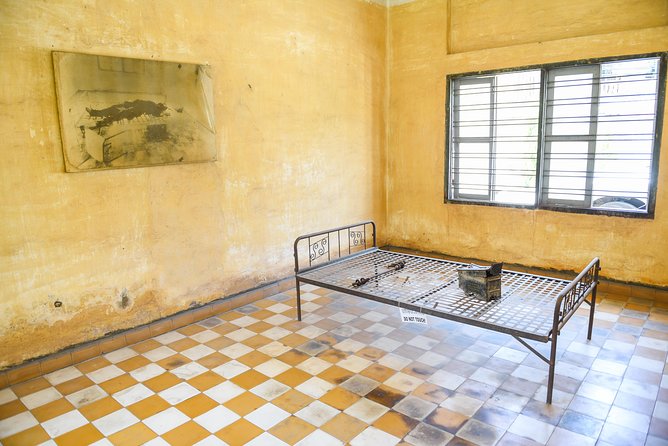
Nestled within the Cambodian countryside lies the solemn Cheung Ek Killing Fields Memorial, a stark reminder of the atrocities committed during the Khmer Rouge era. This memorial stands as a poignant symbol of remembrance for the victims of the brutal regime. To convey a deeper understanding of this historical site, consider the following reflection table:
| Aspects of Cheung Ek Killing Fields Memorial | Description | Importance |
|---|---|---|
| Mass Graves | Commemorates the victims | Honors those lost during the Khmer Rouge reign |
| Memorial Stupa | Holds victims’ skulls | Serves as a reminder of the genocide endured |
| Killing Tree | Used for executions | Represents the brutal methods of the Khmer Rouge |
Visiting this site is not only a lesson in history but also a profound experience in genocide remembrance.
Impact of Atrocities on Cambodian Society

Atrocities committed during the Khmer Rouge era have left a lasting impact on Cambodian society, shaping its collective memory and influencing social dynamics. The scars of this dark period continue to affect the nation in profound ways, impacting both individuals and the community as a whole.
Key points to consider include:
- Social healing: Efforts to address the deep wounds inflicted by the atrocities and promote reconciliation.
- Psychological trauma: The lasting emotional and mental effects on survivors and their families.
- Intergenerational impact: How the trauma and memories are passed down through generations.
- Collective memory: The role of remembrance and memorialization in preserving the history and honoring the victims.
Preserving Memory Through Remembrance Sites
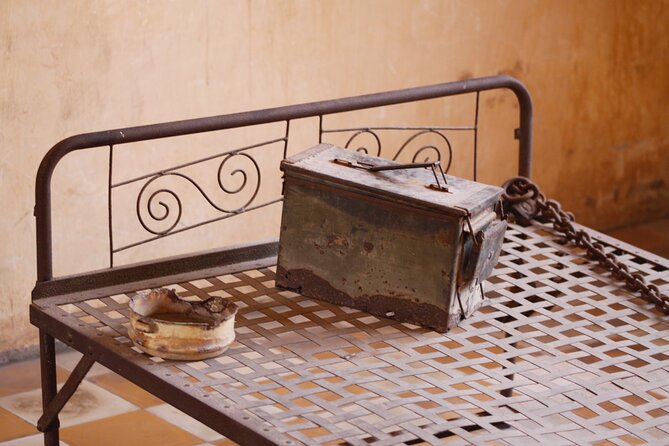
Preservation efforts through poignant memorial sites play a crucial role in honoring the victims and safeguarding the collective memory of the Khmer Rouge era in Cambodia. These memorial preservation initiatives not only commemorate the lives lost but also contribute to trauma healing and education initiatives.
By maintaining remembrance sites like the Tuol Sleng Museum and Cheung Ek Killing Fields, Cambodia ensures that the atrocities committed by the Khmer Rouge regime aren’t forgotten. These sites serve as somber reminders of the past, allowing visitors to pay their respects and learn about the dark history of Cambodia.
Through ongoing commemoration efforts, the country continues to preserve the stories of those who suffered, fostering a deeper understanding of the nation’s history for future generations.
Common questions
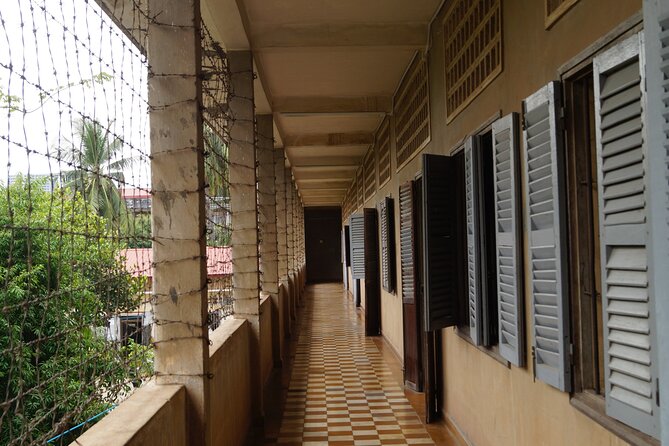
What Are Some Personal Stories or Testimonies From Survivors of the Khmer Rouge Regime That Are Not Mentioned in the Article Sections?
Survivor stories and personal testimonies shed light on the harrowing experiences endured during the Khmer Rouge regime. These narratives offer intimate insights into the resilience and suffering of individuals who faced unimaginable horrors under Pol Pot’s rule.
How Has the International Community Responded to the Atrocities Committed by the Khmer Rouge in Cambodia?
The international community has shown support for survivors’ stories and worked towards justice and remembrance. Efforts include tribunals, memorials, and aid programs. These responses aim to acknowledge the atrocities of the Khmer Rouge regime and prevent such tragedies from reoccurring.
Are There Any Ongoing Efforts to Seek Justice for the Victims of the Khmer Rouge Regime?
Efforts for justice for the victims of the Khmer Rouge regime continue through various legal avenues and survivor testimonies. Victims’ stories are crucial in seeking accountability and ensuring that the atrocities committed are never forgotten.
What Role Did Neighboring Countries Play During the Khmer Rouge Era, and How Has This Impacted Cambodia’s Relationships in the Region?
Neighboring countries played varied roles during the Khmer Rouge era, impacting Cambodia’s regional relationships. Their actions influenced alliances and tensions, shaping diplomatic dynamics. These historical interactions continue to influence modern-day partnerships and collaborations in the region.
How Has the Cambodian Government Addressed the Issue of Educating Future Generations About the Khmer Rouge Era and Its Impact on Society?
The Cambodian government has taken proactive steps in educating future generations about the Khmer Rouge era and its societal impact. Government initiatives include educational programs that aim to raise awareness and preserve historical memory for younger citizens.
Last Words
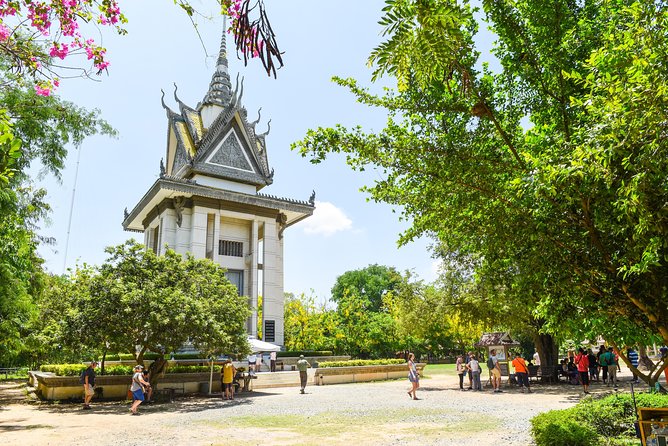
Set out on a poignant journey through Cambodia’s dark past with a tour of the Tuol Sleng Museum and Cheung Ek Killing Fields. Witness the haunting remnants of the Khmer Rouge era and honor the resilience of the Cambodian people.
Through guided exploration and insightful commentary, visitors will gain a profound understanding of the atrocities committed and the importance of preserving memory. This immersive experience ensures a moving and enlightening insight into Cambodia’s turbulent history.